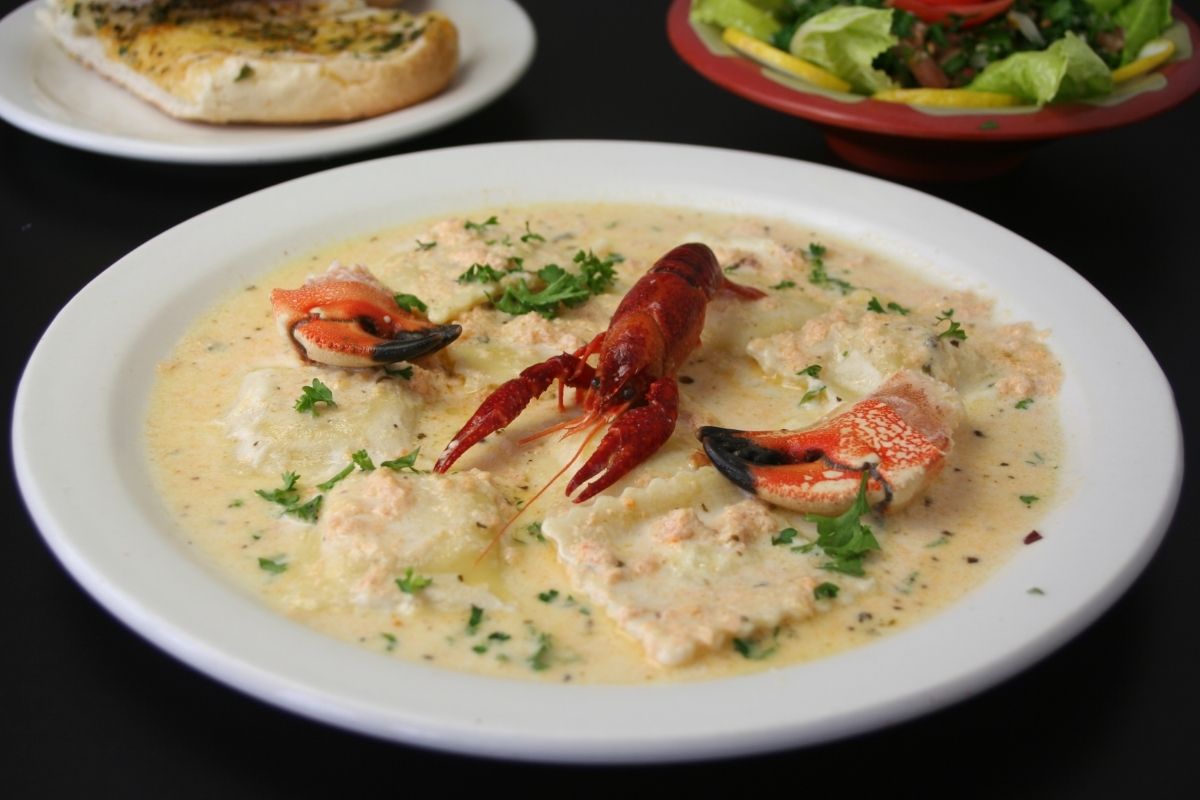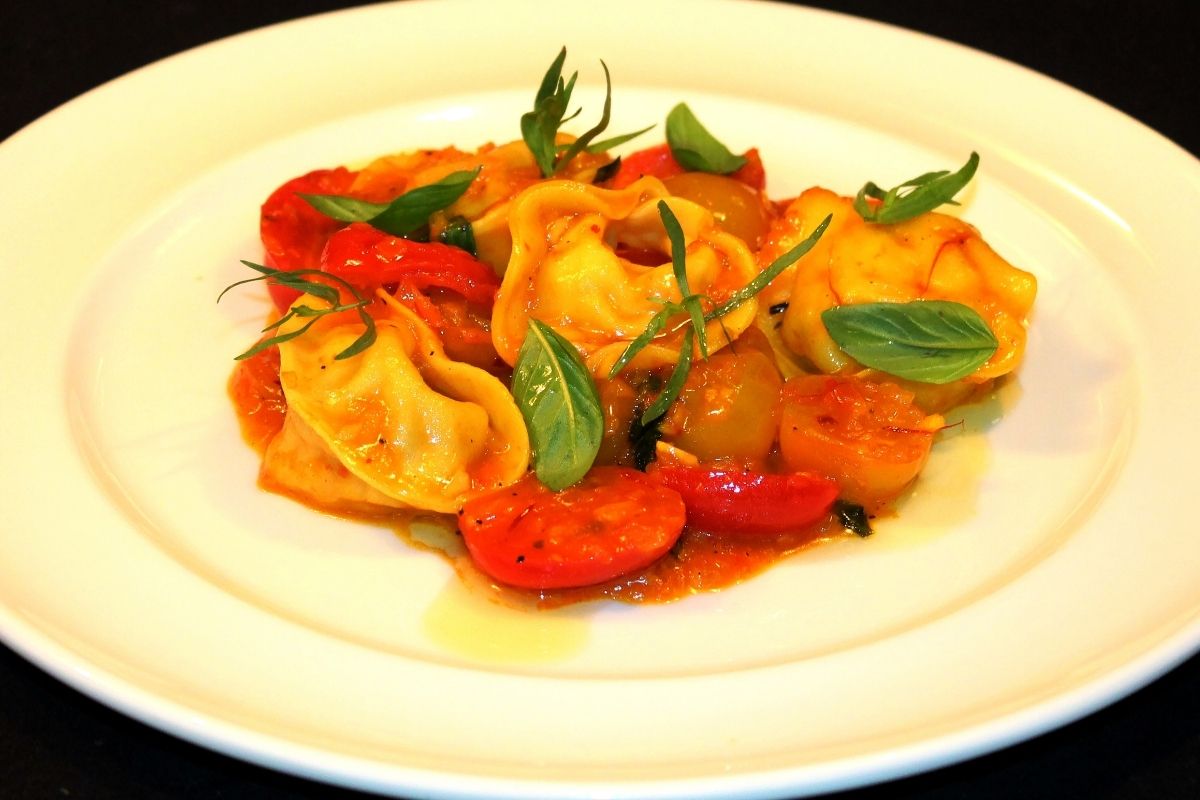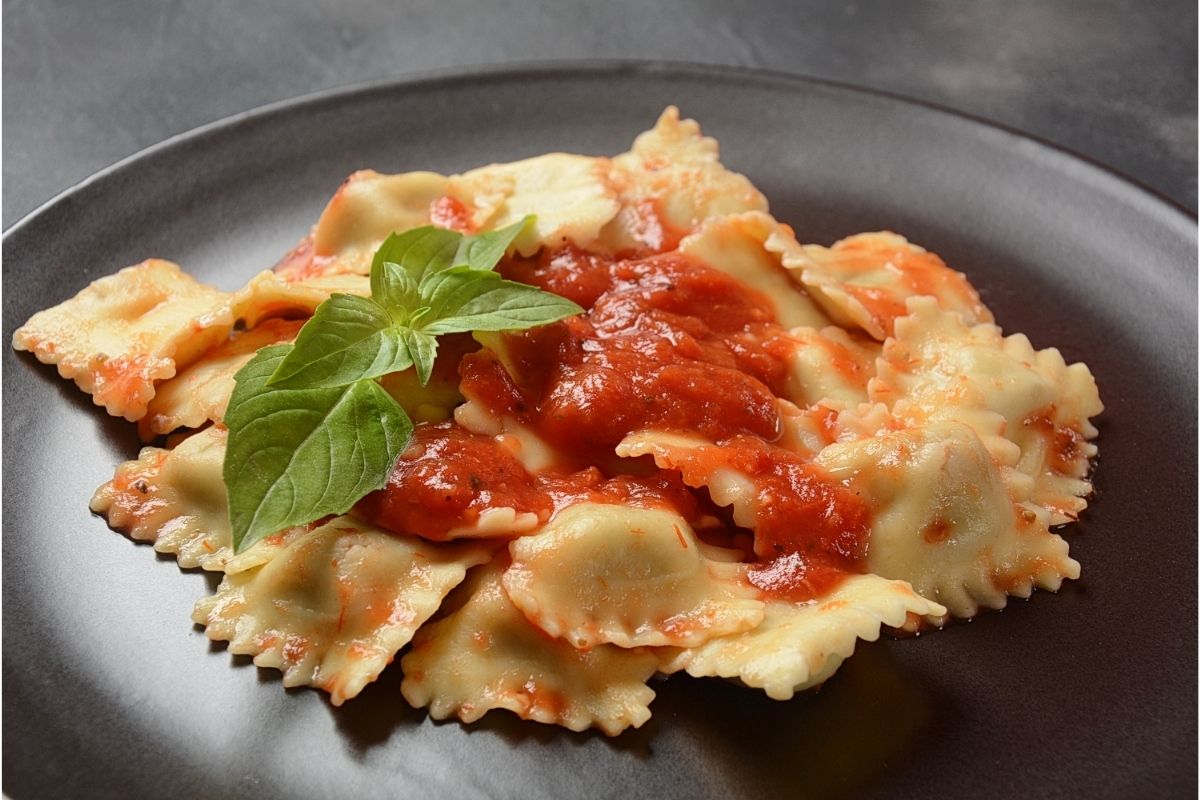The sauce for lobster ravioli is an essential part of the dish. There are many sauce options out there, but it can be hard to figure out which sauce will work best with this type of pasta. The sauce is essential because it can make or break the dish.
If you choose a sauce that is too heavy, it will overpower the lobster’s delicate flavor. On the contrary, if you choose a sauce that is too light, it will not be able to stand up to the pasta and fillings.
The best sauce for lobster ravioli should be rich and creamy but not too heavy. It should also have a bit of acidity to balance out the sweetness of the lobster. To help you choose the perfect sauce for your lobster ravioli, we have compiled a list of our favorite sauces.
We have also included some key ingredients that you will need to make an authentic sauce and our favorite sauce recipe for lobster ravioli.
But before we get into all of that, let’s take a look at what lobster ravioli is and where it comes from.

What is Lobster Ravioli?
Lobster ravioli is a type of pasta containing a lobster-based filling. It features a round or square pasta dough filled with lobster meat, cheese, and herbs. The ravioli is sealed between two layers of dough and served with a sauce.
There are many different variations of lobster ravioli, but the most common fillings include ricotta cheese, mozzarella cheese, and Parmesan cheese.
Herbs such as parsley, basil, and thyme flavor the filling, and you can serve the pasta with a tomato-based sauce.
Lobster ravioli is a popular dish in many restaurants, but you can easily make it at home. All you need is a few simple ingredients and a bit of time. We’ll go over what you need to make an authentic lobster ravioli later on in this article.
For now, let’s look at some of the best sauce suggestions for this type of pasta.
The Best Sauce Suggestions for Lobster Ravioli
Many people think that the only sauce that goes well with lobster ravioli is a tomato-based sauce. However, there are actually many different types of sauces to choose from.
Here are some options to consider:
- Alfredo sauce for lobster ravioli: A classic alfredo sauce is a rich and creamy white sauce made with butter, cream, and Parmesan cheese. It is the perfect sauce for lobster ravioli because it is not too heavy and has a bit of acidity to balance out the sweetness of the lobster.
- Garlic butter sauce for lobster ravioli: Garlic butter sauce is a simple sauce made with butter, garlic, and herbs. It is a light sauce that allows the lobster filling to shine through.
- Creamy sauce for lobster ravioli: A creamy sauce is a rich and creamy sauce made with milk, cream, and cheese. It is the perfect sauce for those who want a more decadent sauce without the acidity.
- Red sauce for lobster ravioli: A red sauce is a tomato-based sauce made with tomatoes, onions, garlic, and herbs. It is a classic sauce that goes well with many different types of pasta, including lobster ravioli.
- Brown butter sauce for lobster ravioli: Brown butter sauce is a rich nutty sauce made with butter, flour, and milk. It is the best sauce for those who want a richer sauce with a bit of depth.
- Vodka sauce for lobster ravioli: Vodka sauce is a tomato-based sauce made with tomatoes, cream, and vodka. It is a rich and creamy sauce with a bit of a kick.
- White sauce for lobster ravioli: White sauce is a light and creamy sauce made with milk, butter, and flour. It is the perfect sauce for those who want a lighter sauce without sacrificing flavor.
- Olive oil sauce for lobster ravioli: Olive oil sauce is a simple sauce made with olive oil, garlic, and herbs. It is a light and healthy sauce that is perfect for those looking for a healthier option.
- Pink sauce for lobster ravioli: Pink sauce is a tomato-based sauce made with tomatoes, cream, and herbs. It is a lighter sauce, perfect for those who want a bit of sweetness without the heaviness of a red sauce.
While there are many different types of sauces to choose from, not all of them will be the best choice for your lobster ravioli. Some sauces can be too heavy and overwhelm the lobster’s delicate flavor, while others can be too light and fail to stand up to the richness of the filling.
The best sauce for your lobster ravioli will depend on your personal preferences. Consider what type of sauce you like best, and then choose one that will complement the flavors in your dish.
Our favorite sauce recipe is a good place to start if you are having trouble deciding what kind of sauce for lobster ravioli.
Key Ingredients for Authentic Lobster Ravioli
To make authentic lobster ravioli, you will need a few key ingredients. These include:
- Fresh pasta dough: You can find fresh pasta dough at your local grocery store or Italian market.
- Lobster meat: Lobster meat is the key ingredient in this dish. You can use fresh or frozen lobster meat for this recipe.
- Ricotta cheese: Ricotta cheese is a mild and creamy cheese that is often used in ravioli recipes.
- Parmesan cheese: Parmesan cheese is a sharp and salty cheese that adds flavor to the dish.
- Egg: The egg is used to bind the ingredients together and help the pasta dough stick together.
- Lemon juice: Lemon juice is added for acidity and brightness.
- Fresh herbs: Fresh herbs are added for flavor. You can use any combination of herbs, such as parsley, basil, or thyme.
- Salt and pepper: Salt and pepper are added to taste.
These ingredients will help you make the best lobster ravioli possible. If you cannot find all of the ingredients, you can substitute with similar items.
For example, if you cannot find ricotta cheese, you can use cottage cheese or cream cheese. If you do not have fresh herbs, you can use dried herbs.
The most important thing is to use quality ingredients so that your dish turns out delicious.

Our Favorite Sauce Recipe for Lobster Ravioli
If you are looking for the perfect sauce to pair with your lobster ravioli, we have the perfect recipe for you.
| Prep Time | 10 minutes |
| Cook Time | 20 minutes |
| Total Time | 30 minutes |
- Serving Size: 4 servings
Nutritional Facts/Info per serving/in total
| Calories | 553 kcal |
| Carbohydrates | 0.18 ounces (5 grams) |
| Protein | 0.11 ounces (3 grams) |
| Fat | 1.8 ounces (51 grams) |
| Saturated Fat | 1.02 ounces (29 grams) |
| Cholesterol | 165 milligrams |
| Sodium | 58 milligrams |
| Potassium | 122 milligrams |
| Fiber | 0.04 ounce (1 gram) |
| Sugar | 0.04 ounce (1 gram) |
| Vitamin A | 1780IU |
| Vitamin C | 2 milligrams |
| Calcium | 95 milligrams |
| Iron | 1 milligram |
*The nutrition information is for four servings.
**This information is an estimate and will vary depending on the ingredients used.
Equipment Needed
- Small bowl
- Sharp knife or kitchen shears
- A large sauté pan or Dutch oven
- Plate
- Large bowl
- Fine mesh strainer
Ingredients
- 4 ounces (113.4 grams) lobster tails: Lobster tails are the show’s star in this dish. It is essential to use fresh lobster tails for the best flavor and texture. If you cannot find fresh lobster tails, you can use thawed frozen lobster tails. Lobster tails are available at most grocery stores.
- 2 tablespoons of oil/ butter: You will need either oil or butter to cook the lobster tails. We prefer using a combination of both for the best flavor. To add even more flavor, you can use extra virgin oil. Neutral oil, such as canola, vegetable, and grapeseed, will also work.
- ½ teaspoon dried thyme: Thyme is a classic herb that goes well with lobster. It adds a bit of earthiness to the dish and helps balance out the lobster’s sweetness. You can use dried or fresh thyme for this recipe.
- 2 teaspoon garlic: Garlic is another classic ingredient that goes well with seafood. For a bit of depth and flavor to the dish, we recommend using finely minced garlic. You can use a garlic press to make this process easier.
- 3 tablespoon onions: Onions add sweetness and depth to the sauce. We recommend using either sweet onion, red onion, or shallots. Yellow onion is not as sweet and can be a bit overpowering.
- ½ cup brandy: Brandy is a liquor made from distilled wine. It adds flavor and depth to the sauce. You can use any brandy for this recipe, but we prefer using a good quality cognac.
- ½ teaspoon old bay seasoning: Old Bay is a seasoning blend of spices like paprika, celery seed, and mustard. It’s often used in seafood dishes and adds a bit of heat and flavor to the sauce. You can purchase Old Bay at most grocery stores or online.
- 2 cups heavy cream: Heavy cream thickens the sauce and adds richness. For a lighter sauce, you can use half and half or milk.
- Salt (Optional): Salt seasons the sauce. We recommend using either kosher salt or sea salt. You can always add more salt at the end if needed.
- Pepper (Optional): Pepper is used to season the sauce. We recommend using freshly ground black pepper for the best flavor.
- Paprika (Optional): Paprika is used to add color to the sauce. If you want your sauce to be a bit pinker, you can add a pinch of paprika.
Directions
- Start by chopping the onions, then set them aside in a small bowl.
- Next, mince the garlic and set it aside in a separate bowl.
- Remove the meat from the lobster tails. You can use a sharp knife or kitchen shears to do this.
- Chop the lobster meat into small pieces of about one inch (2.54 centimeters) and set them aside in another separate small bowl. The smaller the pieces, the more evenly the sauce will be distributed.
- In a large sauté pan or Dutch oven, heat butter and oil over medium heat for two minutes or until hot and bubbly.
- Add the onions and thyme to the pan and sauté for two to three minutes or until the onions are translucent.
- Add the garlic to the pan and sauté for an additional minute. Be careful not to let the garlic burn.
- Add the chopped lobster meat to the pan and sauté for one to two minutes or until it cooks through. Remove and set aside the cooked lobster meat on a plate.
- Add lobster shells (if used) and sauté for two minutes in the same pan. You can add a tablespoon or two of oil or butter if needed.
- Add the brandy to the pan and carefully ignite with a long match or lighter. Allow the alcohol to burn off for about one to two minutes.
- Add the heavy cream to the pan and bring to a simmer.
- Cook the sauce for about five minutes or until it has thickened slightly.
- Add the old bay seasoning and simmer until you reach the desired consistency.
- Once the sauce’s flavor is to your liking, carefully strain out the lobster shells and any large pieces of thyme using a large bowl and a fine-mesh strainer.
- Add the strained sauce back into the pan and gently heat through until it reaches your desired thickness.
- Add salt and pepper to taste (optional).
- Add the cooked lobster meat back into the sauce and heat through for one to two minutes. Gently stir in the ravioli and serve.
- You can sprinkle the finished pasta dish with some freshly grated Parmesan cheese, red pepper flakes, or a squeeze of fresh lemon juice for an extra bit of flavor. Enjoy!
The Origins of Lobster Ravioli
The first mention of ravioli traces back to 14th-century manuscripts. These early dishes were generally served in broth and were quite different from the ravioli we know today.
In the 14th century, ravioli made their way to England, where they were cooked for King Richard II. It wasn’t until the 16th century, that chefs experimented with different fillings and sauces for ravioli. One of the most popular innovations was to cook ravioli with tomatoes and tomato sauce.
Thanks to Chef Boyardee, ravioli became a popular dish in America during the late 19th century. His company, Chef Boyardee Foods, introduced canned ravioli to the United States in the 1930s.
Lobster ravioli is a relatively modern dish that combines the traditional Italian pasta dish with seafood. Lobster ravioli first began appearing on restaurant menus in the 1980s. Marco Pierre White, a renowned British chef, is credited with popularizing the dish.
Today, there are endless possibilities for filling and sauces for ravioli. Whether you prefer a classic tomato sauce or something more unique, there’s a ravioli dish for everyone to enjoy.
Lobster Ravioli Serving Suggestions
As mentioned earlier, lobster ravioli is a bit of a heavier dish. For this reason, it’s best to pair it with lighter side options. Some of our favorite side dishes to serve with lobster ravioli include
- Crusty Bread for dipping
- Grilled Zucchini
- Roasted Asparagus
- Roasted Beets
- Roasted Beet Salad with Goat Cheese
- Roasted Broccoli
- Sautéed Mushrooms
- Sautéed Snap Peas
Whether you’re looking for a classic Italian dish or something with a modern twist, a lobster ravioli is a delicious option that’s sure to please everyone at the table. Just don’t forget the bread for dipping in that delicious sauce!
FAQs on the Best Sauce for Lobster Ravioli
Is It Worth It to Make Your Own Pasta Dough for Ravioli?
While there’s nothing wrong with using store-bought ravioli, we think there’s nothing better than homemade pasta. If you’re feeling ambitious, you can definitely make your own ravioli dough from scratch.
You can also find pre-made ravioli sheets at most Italian markets or online if you’re short on time. These sheets will speed up the process and still result in a delicious dish.
What’s the Best Type of Cheese to Use in Ravioli?
There are so many different types of cheese out there, and it can be tough to decide which one to use in your ravioli. If you’re looking for a classic flavor, we recommend ricotta cheese.
You could also try using goat cheese, Parmesan cheese, or even cream cheese in your ravioli filling for a more robust flavor.
Can I Make Lobster Ravioli Ahead of Time?
If you’re looking to save some time, you can definitely make your ravioli ahead of time. Once you’ve assembled your ravioli, you can store them in the fridge for up to 24 hours.
When you’re ready to eat, simply cook your ravioli according to the instructions and enjoy!
How Do You Cook Frozen Ravioli?
If you’re using store-bought ravioli or ravioli that you made ahead of time, you’ll need to cook them frozen. The following instructions are for cooking frozen ravioli in a pot of boiling water:
- Bring a pot of water to a boil.
- Add a tablespoon of salt to the water.
- Carefully add the frozen ravioli to the pot.
- Cook the ravioli for seven to eight minutes or until they float to the surface.
- Stir the ravioli occasionally to prevent them from sticking together.
- Once cooked, use a slotted spoon to transfer the ravioli to a plate.
- Serve with your favorite sauce and enjoy!

The Final Say
Lobster ravioli is a delicious and decadent dish perfect for a special occasion. While it may be a bit of a splurge, the dish is definitely worth indulging in. Be sure to pair it with lighter side options and enjoy every last bite!

Community of passionate writers and content creators who share a love for Italian heritage, culture, travel, food, and the Italian-American community. Our mission is to celebrate Italy’s rich history and traditions and connect with others who share the same passion.

